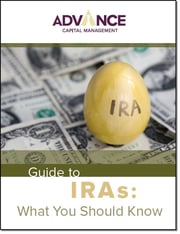Active vs. Passive Investing Pros and Cons: Which Is Right for You?
January 18th, 2023 | 4 min. read

Your investment strategy is a key part of building enough wealth to live a comfortable retirement. Certainly, when considering a financial adviser, one question you should ask is: how are you going to invest my money?
Now, there are thousands of different investments out there, which means there are more ways to build a portfolio than there are atoms in the universe. Yeah, we’re not going to cover them all here. Instead, let’s discuss the two most general investment strategies: active versus passive investing.
There’s an ongoing, and often contentious, debate over whether active or passive investing is better. It’s like the investing version of meat-friendly vs. vegetarian diets. A lot of biased information can come from investors on each side. That’s why we want to provide a clear, even-handed discussion of the topic.
Since 1986, Advance Capital Management’s in-house team of investment experts has created personalized investment portfolios for clients using an active investing approach. But we know that no one investment strategy is perfect, or right for everyone.
Whether active or passive investing makes sense for you relies on your financial goals, assets, level of investing knowledge, and whether you work with an adviser or choose to invest on your own.
In this article, we’ll explain the difference between active and passive investing, including their pros and cons. It will give you a better understanding of what investment strategy matches your personal preferences and goals as an investor.
|
This Article Covers: What Is Active Investing Active investing pros and cons What Is Passive Investing Passive investing pros and cons What Investment Strategy Is Right for You |
What Is Active Investing?
Active investing involves investing in funds that are managed by portfolio managers who choose investments based on their expected performance. The goal of an actively managed fund is to outperform “the market” or a certain benchmark, like the S&P 500.
In response to new information, market changes or economic conditions, active investors try to buy and sell investments to generate higher returns or limit their losses.
Active Investing Pros & Cons
Pros
There are a variety of potential advantages to active investing, such as:
- Above-market returns: Active investing allows portfolio managers to use different strategies to select the most attractive investments, so you may benefit from higher-than-average market returns.
- More choices: There are more actively managed funds to choose from, giving investors greater access to different investments.
- Flexibility: Unlike a “buy and hold” passive approach, active investors make changes to their portfolios in response to market fluctuations, such as a market crash, or economic event like a recession. So, active managers can outperform in times of market volatility or economic decline.
- Tax-loss harvesting: If you are not holding every investment for the long term, you sell your underperforming investments to offset the capital gains taxes on your high returning investments.
Cons
Active investing also has a variety of potential drawbacks to be aware of, such as:
- Higher expenses: Actively managed fund expenses can be higher from paying research analysts and portfolio managers, as well as additional costs due to more frequent trading.
- Below-market returns: When expenses are factored in, many active managers fail to beat their benchmarks.
- Lower tax efficiency: Frequent trading within actively managed funds can lead to paying more capital gains taxes.
What Is Passive Investing?
In passive investing, you are not trying to “beat the market”. Rather, you invest in mutual funds that essentially try to match the performance of certain market indexes. These are index funds or exchange-traded funds (ETFs). They seek to hold the same assets in the same proportion as their benchmark index.
Generally, passive investors hold funds for the long term, making far fewer transactions than with active investing.
Passive Investing Pros & Cons
Pros
Passive investing can be an attractive investment strategy because of benefits, like:
- Lower expenses: Since passive funds simply try to replicate the market, there are fewer transactions and less need to pay for fund managers or analysts, which results in lower fees.
- Better returns over the long term: Data indicates that passive funds can outperform actively managed funds over time. Researchers at S&P Dow Jones Indices have found that over the past 20 years most active fund managers underperform the market, primarily due to fees.
- Tax efficiency: By holding investments for the long term, rather than buying and selling them frequently, you’ll likely pay less in capital gains taxes. Further, there are fewer trades within passive funds than active funds, which can mean less tax consequences.
Cons
Passive investing is certainly not without its own potential drawbacks, such as:
- Limited choices: Passive investing is generally limited to broad index funds or ETFs, without the option of selecting individual assets in the fund. For example, if you invest in an index fund that tracks the S&P 500, you could be overexposed to the stocks that make up the largest portion of that index, like Apple, Microsoft, etc. Also, there are no passive investment vehicles available in some types of investments. This can limit your opportunities as an investor.
- Average returns: Since passive funds seek to mirror the market, it’s highly likely your investment will not gain above-market returns.
So, Active or Passive Investing? Which Investment Strategy Is Right for You?
Many investors can benefit from the best of both worlds.
Because there’s more to investing than simply choosing whether to invest actively or passively. For one, you want an appropriate asset allocation – your mix of stocks and bonds -- suitable for your financial goals and risk tolerance. You want a diversified portfolio to control for risk while capturing growth in different market sectors. Also, you want to limit your investment costs so that you can keep more of your overall return. Lastly, you want to stay invested for the long term, as research shows that it is impossible to time the market.
To that end, it’s possible to combine both active and passive investing within your portfolio. Perhaps, you invest in an index fund for exposure to a relatively stable market sector, like large U.S. stocks, while investing in an actively managed fund for a more volatile sector such as international stocks.
Case in point, the investment team at Advance Capital Management uses a variety of funds to construct our model portfolios for clients. These portfolios are comprised of many of the top mutual funds and ETFs chosen through a systematic investment selection process. Each model portfolio has a specific investment strategy and objective that balances return with risk in a diversified, cost-effective approach.
With that said, the right investment strategy for you is the one that aligns with your personal priorities, timeline and financial goals – and the one you’re most comfortable sticking with over the long term.
If you’re looking for a review of your current investment portfolio or need to create one, you may benefit from meeting with an Advance Capital financial adviser for a free consultation and financial plan.
Just as important as deciding how to invest is deciding where to invest. An Individual Retirement Account (IRA) is one of the most effective ways to save for retirement. Download this complimentary guide to learn about investing in an IRA.
Advance Capital Management is a fee-only RIA serving clients across the country. The Advance Capital Team includes financial advisers, investment managers, client service professionals and more -- all dedicated to helping people pursue their financial goals.


